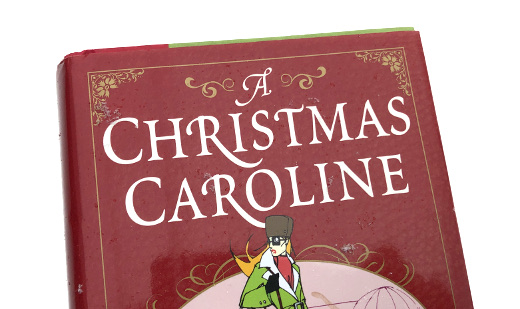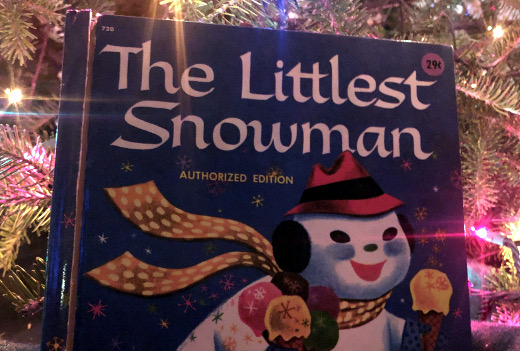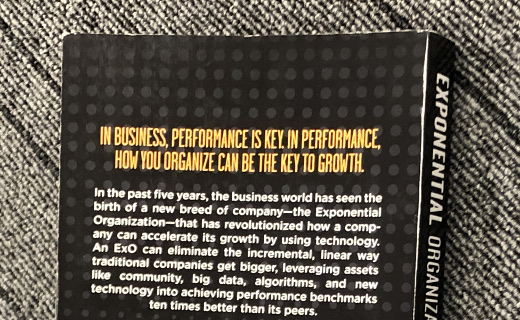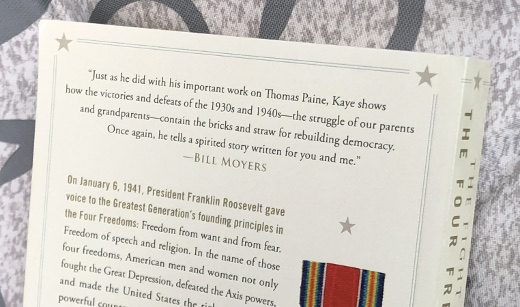My Takeaways From A Christmas Caroline
‘Tis the season to bring out the best in people, as we close out the year with gift giving and gratitude to all who were part of our lives the previous dozen months. ‘Tis also the season for the exact opposite of that, which is the tale told in the book A Christmas Caroline by Kyle Smith.
This story is a modern take on the holiday classic A Christmas Carol. Here, our protagonist is Caroline, an editor for a fashion magazine in New York City who works hard at being beautiful and making sure everyone knows this. As you might guess, she isn’t exactly a nice person. After being fired after nearly burning down her office after insulting her new boss, Caroline is taken through the traditional Christmases past, present and future and in the end everything works out and then some.
Where my takeaways from fiction are not usually the same as their non-counterpart, I have a few after reading this story.
And then some – Caroline’s journey over Christmas is not just a modernized version of Charles Dickens’ tale, as it has some unique twists and contemporary story lines that may resonate more with readers today. Don’t get me wrong, I love the “original” and have read it and seen it over the years on stage and screen. However accounting in the 1800’s doesn’t quite grab someone as much as 2000’s work and life in New York City.
Holiday struggles – From the “first” story where Mary and Joseph couldn’t find a room in an inn and had to settle for a barn, to Caroline’s realizing there’s more to being a member of society than herself, what’s a Christmas story without struggle? If there is such a story, my guess is I wouldn’t want to read it.
After rereading The Littlest Snowman I looked to find another Christmas story that would be better suited to an older reader, and found A Christmas Caroline. I was drawn to it because of its story, and that its author Kyle Smith graduated from my high school a year before me. Though we were both on our school’s team for a local high school TV quiz show, I doubt he remembers me. Smith has written another book that inspired a TV show and is a columnist for the New York Post and National Review. Go Spartans!
Though the holidays are drawing to a close, I recommend picking up a copy of A Christmas Caroline. It has sharp wit on just about every page and was a nice diversion from holiday shopping. As for what I am going to do with my copy, it’s on its way to my cousin, who I know will enjoy it especially the references to the Big Apple.
Yes, click on this or any link in this post and I earn a few cents if you buy the book.
This is from The Hot Iron, a journal on business and technology by Mike Maddaloni.
Did you enjoy this? Subscribe to The Hot Iron by RSS/XML feed or Read by Email
Book Take-Aways • (0) Comments • PermalinkMy Takeaways From Rereading The Littlest Snowman
As it is a certain first of December morning, it’s time for my annual rereading of my all-time favorite Christmastime book from childhood, The Littlest Snowman.
In the spirit of the season, and as a diversion from the usual multi-hundred paged tomes that I have been reading throughout the year, the nearly two-dozen pages of this classic is a welcome treat. As I gently paged through this Wonder Book I couldn’t help thinking of what I do with every other book I read – writing my takeaways from them. In the spirit of The Hot Iron as well, here’s my takeaways from this winter tale.
Selflessness at its core – What is a holiday book without a feel-good story? This one is about the annual tradition on a town where a small boy, who is the only one who knows how, makes the Littlest Snowman along with his neighbor and several anthropomorphic animals. The Littlest Snowman then lights the town’s Christmas tree, followed by the local weatherman declaring it will be a white Christmas. Only that the forecast doesn’t pan out, and it’s up to the Littlest Snowman to save the day by sacrificing himself. Fortunately the story has a happy ending with his remaking.
Why am I the only one I know who knows about this book? – When I tell people about The Littlest Snowman, which was originally published in the 1950’s, nobody has ever heard of it. I have always wondered why, and even did Internet searches on it to no avail. Once again I am either in the minority, or am once again leading a niche.
Why wasn’t this made into a TV special? – With all of the TV specials out there and new (but not necessarily better) ones being created every year, why hasn’t anyone made this book into an animated feature? Or even a live action special? Perhaps it’s because nobody knows about it, or who knows why. As I am not in the position to do so, anyone reading this can feel free to do so.
The process of rereading The Littlest Snowman is a delicate one. As the copy of it I read as a child is long gone, I was able to find a used copy online several years ago. It’s an original print of the story, and is a little fragile. Each year I search for other copies online and find them, but I have decided to make this version the replacement of the one from my youth. You can find your own copy of The Littlest Snowman on Amazon using this affiliate link. That way we can both benefit from making this tale part of your holiday season.
This is from The Hot Iron, a journal on business and technology by Mike Maddaloni.
Did you enjoy this? Subscribe to The Hot Iron by RSS/XML feed or Read by Email
Book Take-Aways • (0) Comments • PermalinkMy Takeaways From Exponential Organizations
Despite all odds and even with all going on in the world, some business just simply flourish. They make headlines and flaunt their success. They do this while driving down the road of fortune, fame and growth that was paved by those who didn’t do so well. But why is this? Is there a “secret formula” some these companies follow that others don’t?
The authors of Exponential Organizations believe there is a pattern to this; companies that leverage the latest in technology, big data, algorithms and the broader community will not only find success, but exponential growth as well. They call these firms ExOs, short for exponential organizations. The approach they modeled in this book back in 2014 has led to a global organization, OpenExO, that consults and trains people on ExOs. As well there are startup consulting firms like BostonExO, which is how I learned about this book, as my good friend Eric Patel started such a firm this past summer.
Intrigued by this, I bought a copy of Exponential Organizations to try to understand better what this was about, and from it I have several takeaways.
Gotta Have Attitude – If you think you can be successful, it will help you more than if you are unsure about it. Upfront I saw this with what they call a Massive Transformative Purpose, or MTP. Typically, someone will say their firm has a vision or mission, but if you want to consider yourself an ExO, you call it an MTP. Where on the surface an MTP and vision statement may look the same, the key to the former in the word transformative, which implied you are making a large, dare I say exponential, impact by what your business does.
Supertankers and Tugboats – The book covers all of the elements of what make up an ExO. In laying these out, it discusses how they can be used for creating a new firm, as well as applying them to an existing firm who likely doesn’t operate anything like a smaller, more nimble entity. A larger firm will setup a smaller firm or simply acquire one, often times integrating the smaller firm in the larger, and often times losing a lot of why they made the acquisition to begin with. The analogy I read of tugboats guiding supertankers really resonated with me – these smaller firms don’t have to be engulfed, and they can guide the larger firm and likely will be vital in their success.
Disrupt Thyself – Another idea I took from the book was to setup your own ExO to disrupt yourself. The thinking is here where you give the start-up money, your data and your intellectual property, and leave them alone. If someone is going to disrupt you, it may as well be yourself, and that way you can use what is created to save your business.
My Thoughts on Version 2 of the Book
As Exponential Organizations came out 6 years ago, a lot has changed in business and the world, and as a result some of the content – especially examples of businesses – is dated. The authors have thus embarked on an endeavor to update the book. In case anyone is interested, I will share my thoughts for a version 2 of the book.
Separate Theory from Examples – Woven in with the principles of what an ExO is are examples of entities that the authors consider either follow well the model of what an ExO are, or don’t. As these are tightly coupled, it can be distracting when a business is mentioned as a good example, but is no longer in existence today, as it was acquired or changed since the initial publication. This, however, is not just a challenge for this book but many I have read over the years, as businesses always come and go. Separating theory from examples will go a long way to keeping the main ideas relevant, even though the examples down the road may not be.
More Relatable Examples – Many of the examples of what an ExO were entities that seemed out of reach to me – Amazon, Zappos, Tesla, Google. Many books cite these businesses as pinnacle examples, and certainly they are. But for the average person, these businesses almost seem irrelevant; if you don’t become the next Google, are you a failure? There are certainly businesses that are smaller in scale, scope, yet truly transformative and exponential, and there should be a focus on them. Companies founded by people who were directly inspired by reading Exponential Organizations would be the ultimate examples.
An Online “Addendum” Connected by QR Code, Subscription – Almost every book has an accompanying Web site these days, and tucked away on them is an “errata” or section on changes to the book since the print copy went into the wild. The previously mentioned thoughts for version 2 should also leverage the Web or an app for this, and could tie them together with a QR code in each section of the book or an email newsletter subscription or RSS feed to notify readers of the book as to these types of changes. Registered users could even get an overall updated copy of the book over time when the authors decide to fold these changes into the published version.
Passing Along The Learning
As I do with all books I read, I pass it along once I have finished it and have written my takeaways here at The Hot Iron. In this case I am sending it to a work colleague. There are changes going on in our organization, and I want to share these ideas as they may be relevant to what we are doing.
I recommend Exponential Organizations to anyone starting a new business or working in an existing one. The ideas here can help you in evaluating how to move forward with projects and changes in your organization towards a transformative journey.
Editor’s Note: All links to the book are Amazon affiliate links, which means if you click on them and buy the book, then I make a few pennies.
This is from The Hot Iron, a journal on business and technology by Mike Maddaloni.
Did you enjoy this? Subscribe to The Hot Iron by RSS/XML feed or Read by Email
Book Take-Aways • (0) Comments • PermalinkMy Takeaways From List Your Self
Writing about oneself is tough for some people, including myself. Where someone may be comfortable writing on any other topic, when it gets personal it can become a challenge. Think about it –you are staring at a blank sheet of paper or screen and wanting to put something down that has never been written before. But once started, it becomes less of a burden.
This is the idea behind List Your Self. It is a journal with prompts that ask you to tell the story of you by listing things about you. Examples of list include “list all the names you’ve been called, endearing and not so” and “list all the things you’d like to say to your mother.” There’s a wide variety of lists under categories like “growing up,” “men and women,” and “greater truths.”
As I went through the book, which I finished recently, I took away a lot from it and its exercises.
It made me think – Where listing my favorite foods as a child poured from my brain like a waterfall, other topics took some mental gymnastics to answer. Whether I forgot about it or tried to put it out of my mind I don’t know, but I did fill out something for each and every page and list prompt.
Some lists were easier than others – Even if what I was going to put down on a list was top of mind, there were times that it was hard to write. I chalk it up to what I said in the opening, as some of these things are being put down in a tangible form for the first time. Nothing salacious or illegal though… as far as you know.
It took a while – I started the book back in 2016 and just finished it now midway through 2020. Where I tried to do one page a day, there were periods – like when I moved – that I had the book packed away and then unearthed it and started back into it. I had a similar experience with the exercises in 1 Page At A Time. Near the end I really just wanted to finish it and did several pages a day.
If you’d like to start chronicling your life, or simply give yourself a daily challenge of a different kind, I highly recommend List Your Self. This book was given to me as a gift, and as it’s full of personal stories of myself I am clearly not passing it along to anyone else! What I am going to do is pass along another journal to another friend, one of a similar genre but more about telling my life as a father… namely as I have another book very similar to it and started back when I first became a father but never came close to finishing it. Needless to say I have restarted this other journal and am taking it one page at a time.
This is from The Hot Iron, a journal on business and technology by Mike Maddaloni.
Did you enjoy this? Subscribe to The Hot Iron by RSS/XML feed or Read by Email
Book Take-Aways • (0) Comments • PermalinkMy Takeaways From The Fight For The Four Freedoms
For myself growing up in New England, I was always interested and intrigued about the history of the United States. As a child, I was engrossed with the celebration of the Bicentennial of our country. Being in the area where early events in America happened, it was almost like I was absorbing history rather than studying it.
For a lot of the rest of the history of my homeland, however, I don't know it to the same level of depth. Much of it to me is top-line to the timeline, but without a lot of the minutiae. This is why I was interested in reading The Fight for the Four Freedoms by Dr. Harvey Kaye. I learned about the book after I heard Kaye on local radio interviews. I borrowed a copy of the book from a friend to learn the author's take on this time in history.
My takeaways from the book were a mix of thoughts on myself and history.
I had no recollection of ever learning about the Four Freedoms – As I read through the book, I often ask myself, why didn't I already know about this? Thinking back on what I learned in public schools, that one history class in college, stories from family members who lived through that era as well as my own personal reading, I knew a lot of the basics – the Great Depression, President Franklin Delano Roosevelt (aka FDR), the New Deal, Social Security and of course the U.S.’s entry and time in World War II. All things considered, I can’t recall the Four Freedoms at all.
In short, the Four Freedoms were goals or quests FDR had for America: freedom of speech, freedom of worship, freedom from want and freedom from fear. He first presented these when he addressed Congress in January, 1941. I know the first 2 are in the U.S. Constitution. The last two, in my own assessment, are “covered” with the phrase “life, liberty and the pursuit of happiness” in the U.S. Declaration of Independence.
There were a lot of government “acronym” agencies during this time, and now – Thinking back on my own history lessons, I knew about the Work Progress Administration (WPA) and the Tennessee Valley Authority (TVA), but that was about it. The book lists programs after program, agency, after agency, and all were referred to the acronym for their much longer names. We of course have this today, with new ones created just this year. If I were to look back my guess is there were more in between and even before this time. Each acronym comes with its own overhead needs to exist: budget, staff, etc., and one always hopes the results are worth the effort to create it.
History plus opinion of this period of time – I knew going into the book, from listening to him on radio interviews, the author has strong liberal / progressive political views. As I read the book, this was evident in the very positive tone given to FDR and all that government did, in contrast to the negative tone towards business and free enterprise. Granted from my own knowledge I know all wasn’t good from business, and many had the same feelings towards the government. I was able to read beyond this, however, and still got the essence of the Four Freedoms. Not bad for a self-described centrist and supporter of business and entrepreneurship.
I recommend The Fight for the Four Freedoms for anyone who is interested depth on this topic and period of time. It painted a good picture of the beliefs of FDR, those who followed him and the meaning behind his goals. As I borrowed this book, I returned it to its rightful owner and did not pass this one onto someone else.
This is from The Hot Iron, a journal on business and technology by Mike Maddaloni.
Did you enjoy this? Subscribe to The Hot Iron by RSS/XML feed or Read by Email
Book Take-Aways • (0) Comments • Permalink





